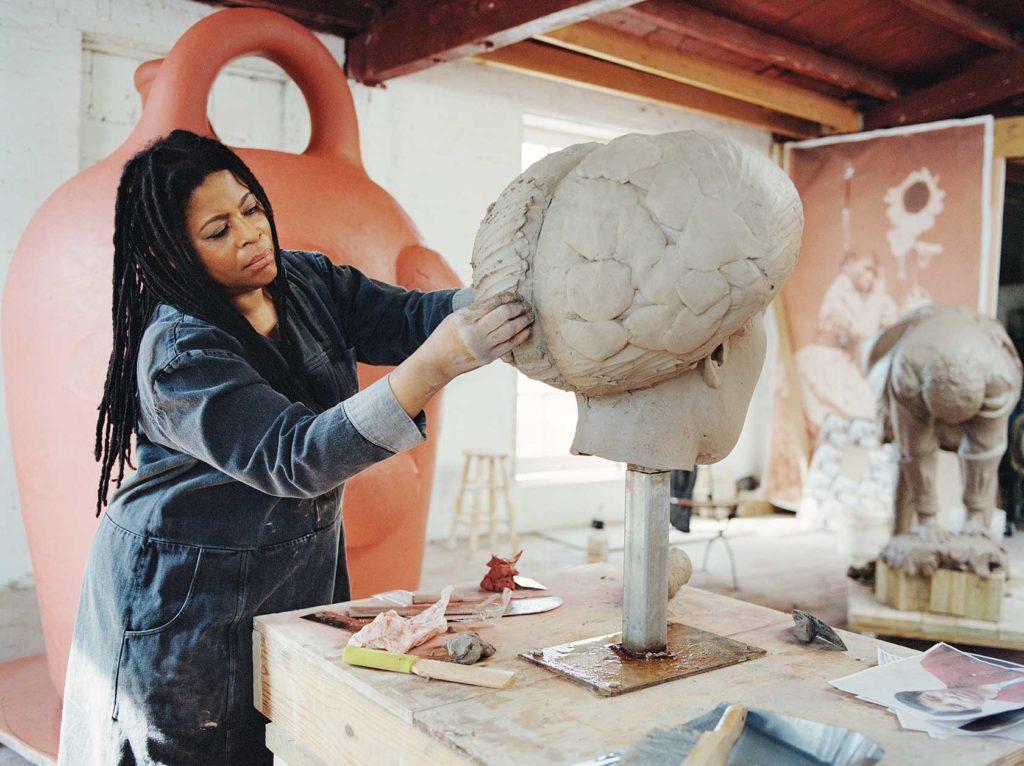Simone Leigh: Giving shape to the lives of Black women
Sculptor to represent U.S. at 59th Venice Biennale

Oval and circular shapes dominate Simone Leigh’s sculptures, semi-abstract female figures in terra cotta, bronze and ceramic that exude the power of totems.
Many are heads and busts encircled by raffia skirts, earthy figures that honor the labor and resilience of Black women. Drawing upon artistic traditions of Africa and the African diaspora, they are icons of strength in daily life, not remote goddesses.
In 2022, a pantheon of such figures will populate the U.S. Pavilion of the 59th Venice Biennale, where Leigh will represent the United States. Every two years for more than 120 years, from April through November this major art world event has showcased contemporary artists from almost 100 countries.

Simone Leigh, 2021. Artworks © Simone Leigh. Courtesy the artist and Matthew Marks Gallery. PHOTO: SHANIQWA JARVIS
“This will be the first time the U.S. Pavilion is entirely dedicated to the experiences and contributions of Black women,” said Jill Medvedow, director of the Institute of Contemporary Art Boston (ICA) and 2022 U.S. Pavilion co-commissioner.
The works in Leigh’s exhibition for the Biennale will also be shown in the artist’s first museum survey exhibition, which the ICA will present from April through September 2023. The exhibition will then go on tour to museums nationwide.
The U.S. is one of 30 nations with permanent pavilions in the Giardini, a forested park along the Venetian Lagoon. Still more exhibitions fill the cavernous Arsenale, where Venice built a maritime fleet that during the 12th through 16th centuries ruled European trade.
Leigh’s exhibition will occupy a structure built in 1930 as a small-scale version of Thomas Jefferson’s Virginia mansion, Monticello, complete with Doric columns and a rotunda. Its title, “Simone Leigh: GRITTIN,” evokes the spirit of resilience expressed by her figures as well as their substance — sturdy earthen materials.
Leigh, 54, has been working in sculpture, video, performance and social practice for more than two decades. Her projects focus on Black female experiences and social histories.
Incorporating the value of manual labor into her practice, Leigh crafts the entirety of her figures with her own hands, shaping full-size clay models, rather than forming miniatures to be cast by others’ hands.
In addition to her exhibition, Leigh will host a three-day symposium at the Biennale that convenes Black female scholars, artists and activists from around the world. Its performances, film screenings, and panels will nurture intergenerational and interdisciplinary connections.
Major museums collect and exhibit works by Leigh, who is the recipient of important prizes that include the Studio Museum of Harlem’s 2017 Joyce Alexander Wein Artist Prize and the Guggenheim Museum’s 2019 Hugo Boss Prize.
Some of her sculptures are also public art. Leigh’s towering “Brick House” (2021) looms over 30th Street in Manhattan. The first large-scale sculpture on the High Line, the landmark pedestrian park along the Hudson River, the 16-foot-tall bronze bust of a Black woman has a torso that combines the shapes of a skirt and a house. The monumental sculpture is part of Leigh’s “Anatomy of Architecture” series, which embeds into female figures architectural forms of regions laden with Black cultural histories, such as West Africa and the American South. Visible from afar, Leigh’s High Line figure equates the strength, protectiveness and endurance of a Black woman to a home built out of brick.

![Banner [Virtual] Art Gallery](https://baystatebanner.com/wp-content/uploads/2024/04/NJ-H_1-150x150.jpg)


![Banner [Virtual] Art Gallery](https://baystatebanner.com/wp-content/uploads/2024/04/NJ-H_1-713x848.jpg)

